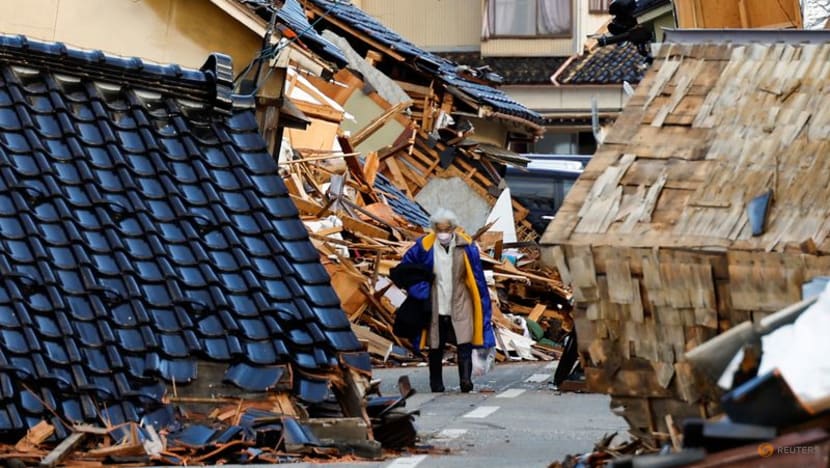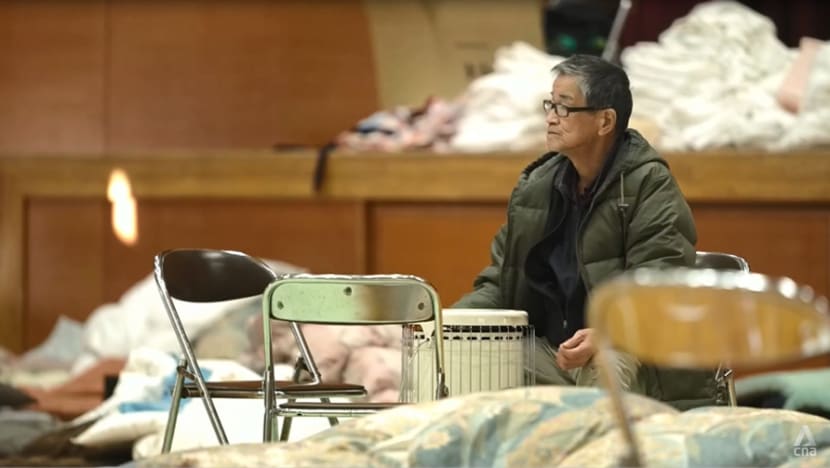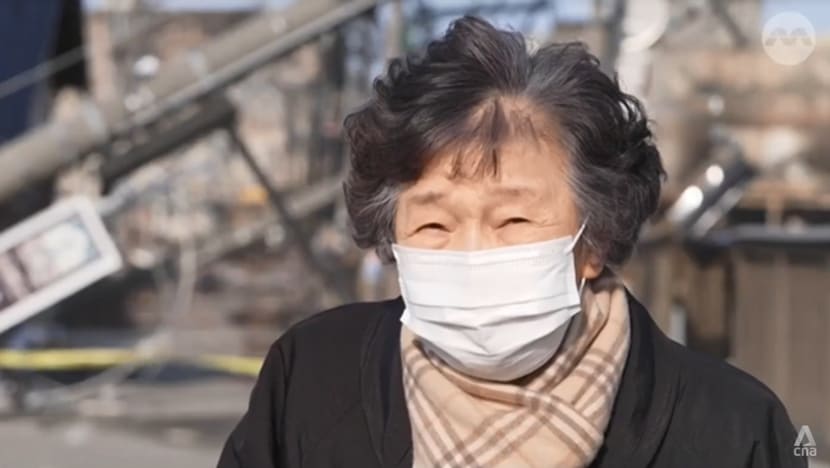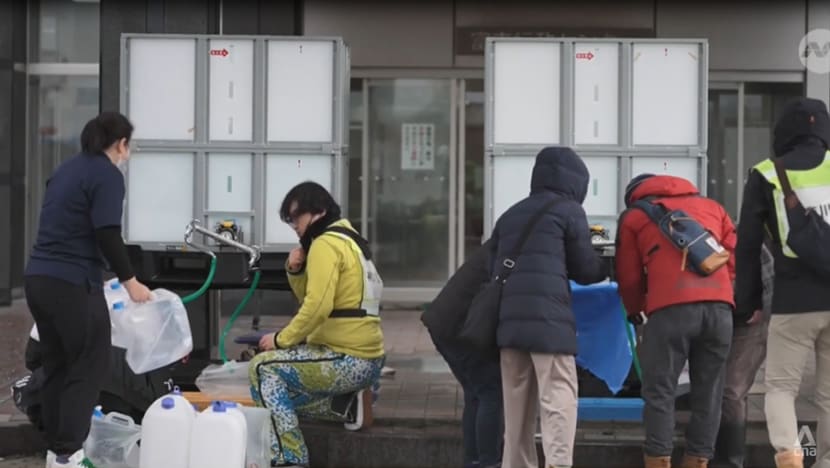‘I feel so helpless’: Quake-hit cities in Japan grapple with damage and loss of lives
Hundreds of evacuation shelters have been set up across the central Ishikawa region, as tens of thousands of households remain without electricity or water.

A woman, whose house was damaged by an earthquake carries her belongings as she heads to an evacuation centre, in Wajima, Ishikawa Prefecture, Japan, January 5, 2024. REUTERS/Kim Kyung-Hoon

This audio is generated by an AI tool.
ISHIKAWA, Japan: Once a popular tourist spot, the hot spring resort town of Wakura is now a scene of devastation and despair following the major New Year’s Day earthquake in central Japan.
The town, which houses the biggest hot spring resort on the Noto Peninsula, is one of the worst-hit areas in the Jan 1 disaster.
It quickly turned what would usually have been the height of the town’s tourism season into an evacuation nightmare.
As structures toppled and cracks appeared on the roads, residents and visitors rushed to seek shelter at Wakura Elementary School, the town’s main evacuation centre.
“I’ve never experienced anything like this,” said Ms Haruko Hoizumi, an 84-year-old resident who was working at one of the town’s many hotels when the disaster struck.
“I used to think what happened in Iwate was enormous. When this happened to me, it’s so hard,” she added, referring to the 2011 magnitude 9 earthquake which triggered a tsunami that caused the Fukushima Daiichi nuclear disaster.
Another resident, Mr Daisuke Sakabe, evacuated to the elementary school with his wife and two-year-old son after the quake damaged his residence.
“My home is in total ruins. The water supply has stopped. I feel so helpless with a child,” said the young father.
Businesses including lodgings, restaurants, and hot springs – also known as onsens – have shuttered amid fears that powerful aftershocks will continue to rock the area.
Instead, nearby hotels and inns donated their Japanese style bedding – known as futon – to the shelter so that evacuees could stay warm.

For tourism-related businesses, the earthquake ruined not only high season sales, but also critical infrastructure that could hamper the town’s main industry for months or years to come.
“Wakura is basically strong in tourism. (The neighbouring city of) Nanao is also a tourist site. There is a deep impact on tourism,” said Mr Shigeaki Kakishima, chairman of the Wakura Town Union.
RISING DEATH TOLL, TOUGH RESCUE CONDITIONS
A week after the quake, the death toll has risen to at least 168 as of Monday (Jan 8), according to authorities. More than 300 people are still unaccounted for, as snow and storms further complicate rescue efforts.
Shockwaves had toppled buildings and triggered tsunami waves over a metre high.
“I was scared. It’s my first experience. I heard an announcement: 'A tsunami is coming'. There’s a school right near us. We were told to evacuate immediately,” Mr Fumio Yoshino, a taxi driver in the Ishikawa prefecture capital of Kanazawa, told CNA his experience when the quake hit.
Continuous rain has increased the risk of fresh landslides, and heavy snow could cause more buildings to collapse under its weight, regional authorities warned.
Amid worsening weather conditions, the Japanese government has vowed "ceaseless" support to devastated areas.
“It is very urgent to reach the isolated villages in the northern areas of the Noto Peninsula,” said Prime Minister Fumio Kishida, who held an emergency disaster meeting on Monday.
“I’ve told relevant ministries and departments to work together so that we can gain access to all the coastal areas, including the national route 249 which was devastated (by the earthquake), not only from land but also from sea. We would like to speed up the emergency recovery with a two-pronged strategy.”
Hundreds of evacuation shelters have been set up across the region, as tens of thousands of households remain without electricity or water.
The prefecture, like many parts of Japan, is ageing fast. Authorities and residents worry if there are enough young people around to help with the post-earthquake clean up and rebuilding.
WAJIMA A GHOST TOWN AFTER MASSIVE FIRE
In Wajima, the largest city on the Noto Peninsula, the quake ignited a massive fire that reduced parts of neighbourhoods – including a historic marketplace – to ash.
The city was the closest to the epicentre of the powerful earthquake and has reported the highest number of lives lost in the disaster.
From Kanazawa, it took CNA six hours to drive to the city instead of the usual two hours, with traffic hampered by steep cracks on the roads and remnants of mudslides.

Ms Fusako Hatanaka, an elderly resident in her 70s, told CNA many of her neighbours perished in the disaster.
“An 11-year-old boy came from Kanazawa for the New Year. He was buried alive. For four days nothing could be done. He passed away,” she said. “A grandma who lived nearby, and her grandchild, were also buried alive. They both died.”
Wajima is a city famous for its lacquerware production. A building representing the local craft skills collapsed on top of a home, killing a woman.
Since the disaster, much of the city is in ruins, with many structures devastated by flames. It is not yet clear what caused the blaze.
As the aftershocks decreased, residents emerged on the streets to examine the ruins of their homes, with many choking back tears.
Ms Yukako Oke, a local who lived near the town’s burnt-down commercial street and is now staying in an evacuation shelter, said she was still in shock at the scale of the destruction.
“I am just totally appalled. I never imagined my town would become like this,” she said.
CONCERNS OVER AFTERSHOCKS, NUCLEAR PLANT
Japan’s Meteorological Agency said over 1,000 aftershocks have been detected, and warned that more are still possible.
The strongest jolt over the weekend took place on Saturday night in the city of Shika.
The city of 18,000 also recorded the strongest seismic tremor during the Jan 1 quake, registering a 7 – the highest on the Japanese seismic intensity scale.
66-year-old Masahito Yamamoto, who is the head of Togiryokemachi ward, was celebrating New Year’s Day with his family in the city when the quake hit last Monday. He said the adults shielded the children with their bodies.
“It was a strong bang from below, Then we were rocked sideways. I don’t remember exactly but I think they were vertical, horizontal and slanted movements,” he said. “It was a chaotic tremor. I thought it was the end of my life.”
While his house is still standing, wardrobes and other furniture have been damaged. There are also many cracks on the walls, and the structure has slightly tipped, he said, adding that if another big earthquake strikes, there is a high chance the entire structure could collapse.
He said he has decided to demolish the house and rebuild it from scratch.

As the entire neighbourhood has no running tap water, an emergency water distribution spot has been set up so that residents can gain access to clean water. Temporary toilets have also been put in place.
Another major concern in the city is the presence of a nuclear plant with two reactors. While both were offline during the earthquake, there are fuel rods inside the facility.
Following the 2011 Fukushima nuclear accident, the Shika plant was temporarily shut down for the construction of safeguards against possible tsunamis, in compliance with new regulatory requirements. Workers have been preparing the plant has for a restart ever since.
Residents have mixed concerns over the facility.
“We are not worried. Maybe because we haven’t experienced what Fukushima had. I feel safe because they (the reactors in Shika) are not operating,” said one resident.
However, another local who is against the nuclear plant said: “I want them (the authorities) to decommission it. It’s dangerous. Very dangerous. They should not have built it in Shika at all.”
Water to cool spent fuel was spilled during the earthquake, according to the plant’s operator Hokuriku Power Company. But it said there is no abnormality to the radiation level.
Local authorities have tried to assure residents that the plant is safe, having been built on a strong foundation to withstand major earthquakes.

















